
Key findings from the case studies are: Scale matters. Geographic areas that are identified as hotspots at the global scale may have a highly variable spatial distribution of risk at finer scales.
Scale affects data availability and quality. Hazard, exposure, and vulnerability data are available at subnational resolutions for individual countries and even cities, as the analyses for Sri Lanka and Caracas show. More comprehensive, better quality data permit more complete, accurate, and reliable identification of multihazard hotspots at finer scales of resolution.
Scale affects the utility of the results. Better data resolution and a richer set of variables contribute to results that are more relevant for national-to-local scale risk management planning, as illustrated in the case study from Caracas. This is very important, as decisions made at local and national scales have perhaps the greatest potential to directly affect risk levels, both positively and negatively.
The global- and local-scale analyses are complementary. In some instances, national-to-local level risk assessors and planners may be able to “downscale” global data for finer-scale risk assessment to compensate for a lack of local data. Ideally, however, global analyses would be scaled up—generalized from more detailed larger-scale data. In practice, many barriers still remain.
Resource collections
- UN Habitat - Urban Response Collection
- Urban Response - Urban Crisis Preparedness and Risk Reduction
- Urban Response Collection - Community Engagement and Social Cohesion
- Urban Response Collection - Economic Recovery
- Urban Response Collection - Environment and Climate Change
- Urban Response Collection - Housing, Land and Property
- Urban Response Collection - Urban Crisis Response, Recovery and Reconstruction
- Urban Response Collection - Urban Resilience